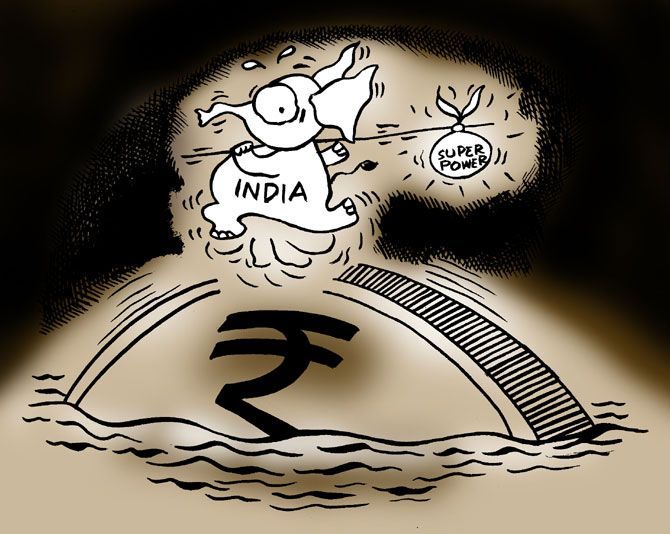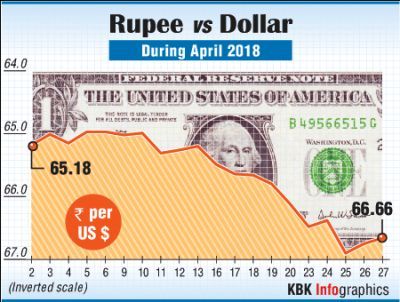Year-to-date, the rupee is the worst-performing currency in Asia, weakening 4.184 per cent against the US dollar.
Illustration: Uttam Ghosh/Rediff.com

The Reserve Bank of India (RBI) has started intervening in the currency market, a move, many players say, would be a one-way street because the rupee is expected to remain volatile and weaken further.
The RBI’s official stand is that it doesn’t target a level for the rupee but irons out volatility.
The volatility in the currency market increased recently.
“Earlier, a 20-30 paisa movement in the exchange rate was considered extreme, but now it seems even a 50-paise movement daily is normal,” said a senior currency dealer with a foreign bank.
After falling to 66.90 a dollar on Wednesday, the rupee started recovering on heavy RBI intervention.
It closed at 66.66 a dollar on Friday, from its 66.76 level on Thursday.
 Currency dealers said they did not take long positions because of the long weekend, helping the rupee to recover its strength.
Currency dealers said they did not take long positions because of the long weekend, helping the rupee to recover its strength.
The RBI probably did not intervene much on Friday after its heavy intervention on Thursday.
The RBI’s foreign exchange reserves came down by $2.5 billion to $423.58 billion in the week ended April 20.
Forex dealers say this is the result of the RBI’s direct intervention.
After remaining stable for a considerable period, the rupee has started sliding rapidly against the dollar after the greenback recovered from its multi-year low.
The central bank had so far accumulated reserves on account of the portfolio flow, but those flows are reversing now.
Therefore, the accumulated reserves could be used against the outflow, just as it was gathered.
“Our estimates suggest that the RBI’s intervention can be to the extent of $8-10 billion,” said an economist at a private sector bank.
If the central bank is willing to maintain its reserves, it can let the forward positions of nearly $20 billion mature.
Besides, the RBI also earns interest on foreign currency deployed, and that may add another $4-5 billion.
The net result will be a surplus for the reserves position, but it will reduce the central bank’s operational flexibility.
Hence, much of the forward positions could be rolled over, and reserves will have to go down a bit.
A few months ago, the RBI had a forward position of nearly $32 billion.
The dollar index, which measures the greenback’s strength against major global currencies, rose 0.38 per cent to 91.907, from its January level of about a little more than 89 per cent.
It doesn’t seem the dollar’s strength will reduce soon. A report by Morgan Stanley Investment Management said the dollar rally would continue.
Growth in the eurozone is plateauing, while China faced headwinds.
“These conditions, coupled with risk sentiment staying supported, which may continue the steepening of the US yield curve, should keep the USD rallying,” Morgan Stanley said.
This would mean pressure on the rupee would continue and the RBI will have to continue intervention.
Year-to-date, the rupee is the worst-performing currency in Asia, weakening 4.184 per cent against the US dollar.
The situation may worsen even more as investors liquidate their holdings in the equity and debt markets.
In April alone, foreign investors took out funds worth more than $2 billion from the bond and equity markets, putting pressure on the rupee.
“It is going to be one-way intervention for the RBI. Only when growth recovers, crude oil prices soften and the US dollar cools a bit can the rupee expect to gain some strength, but that’s a long shot,” said the economist with the private bank.
Also, economists say the inclusion of India in the watchlist of the US Treasury as a potential currency manipulator doesn’t mean much, but may weigh on somewhat on the RBI’s intervention abilities.
However, this time the RBI is intervening to strengthen the rupee, and not to depreciate it, and therefore this should not concern anyone.











